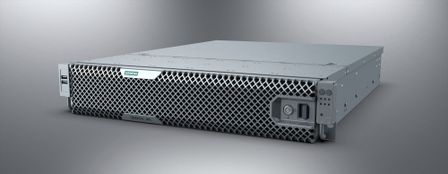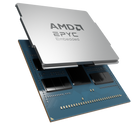Case Study
The performance and connectivity advancements achieved with the new AMD EPYC™ Embedded 9004 Series processors have caught the attention of industrial system designers everywhere. Industrial automation powerhouse Siemens was among the first to embrace the new processors into its product portfolio, where it powers Siemens’ new SIMATIC IPC RS-828A industrial edge servers. 
The modularity and compute agility delivered with Siemens’ SIMATIC IPC RS-828A industrial edge servers make them a perfect fit for hyperconverged infrastructure (HCI) servicing a wide range of applications. HCI brings data and AI-guided decision-making agility closer to the end users and end infrastructure where it’s needed, and for industrial apps, the needs are growing more compute-intensive all the time. Heavy computation is often needed directly at the production line for AI and visual computing workflows, and this requires datacenter-class server performance in a compact, ruggedized system.
At the industrial edge as envisioned by Siemens, field data can be crunched and exploited locally with no performance compromises. Siemens’ SIMATIC IPC RS-828A industrial edge servers are optimized to acquire and process data directly and securely at the machine itself with almost no latency – no cloud datacenter needed. This allows users to analyze all the data where it resides, or preprocess it quickly and instantly.
DIGITAL TWIN INNOVATION
One of the more interesting and advanced use cases for Siemens’ SIMATIC IPC RS-828A is in the digital twin technology domain. Until now, the testing and simulation of industrial systems required the use of physical sensors to monitor motors, pumps, or machinery etc. These sensors handle the conversion of physical and chemical variables to electrical signals fed back to the compute platform for processing.
The problem is it can be extremely difficult and/or expensive – and in some cases, impossible – to deploy physical sensors precisely where they’re needed to take measurements in many industrial settings. Leveraging virtual, software-based sensors instead, in a manner that produces a digital twin of the physical model, the desired measurements (and measurement variables) can be acquired quickly and easily via simulation.
Siemens is a leader in digital twin technology for industrial applications, and we’re excited to be working with them and others to advance the state of the art. In this snapshot perspective courtesy of the Siemens blog, you can read more about how Siemens is leveraging digital twins via small edge computers – exemplified by the SIMATIC IPC RS-828A – in Siemens’ pioneering new virtual sensors for industrial motors.
For a deeper dive on the SIMATIC IPC RS-828A, be sure to check out this companion case study addressing the many benefits Siemens achieved with the AMD EPYC™ Embedded 9004 Series. The expansive core count and PCIe connectivity were among the many benefits, plus our prowess in datacenter apps helped pave the way to this new class of industrial edge system designs. Read all about it here .
 The breakthrough performance profile of the new AMD EPYC™ Embedded 9004 Series processors has made it a big hit among customers and partners, some of whom we had opportunity to showcase at the recent Embedded World event. Stay tuned at this blog and elsewhere for more highlights in the days and weeks ahead!
The breakthrough performance profile of the new AMD EPYC™ Embedded 9004 Series processors has made it a big hit among customers and partners, some of whom we had opportunity to showcase at the recent Embedded World event. Stay tuned at this blog and elsewhere for more highlights in the days and weeks ahead!
To learn more about how AMD Embedded processing solutions are enabling industrial automation leaders like Siemens to innovate high performance edge servers, visit https://www.amd.com/en/processors/embedded-epyc-9004-series.